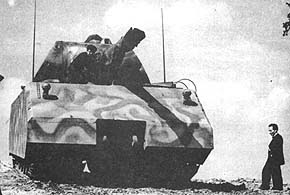 Panzer VIII Maus
Panzer VIII MausType: Superheavy tank
Place of origin: Nazi Germany
Weight: 192 metric tons
Length: 10.09 m (33 ft)
Width: 3.67 m (12 ft)
Height: 3.63 m (11.9 ft)
Crew: 6
Armor: 60–240 mm (2.3 - 9.4 inches)
Primary armament: 128 mm KwK44 L/55
Secondary armament:
co-axial 75 mm KwK 44 L/36.5
7.92 mm MG34
Engine:
MB517 Diesel
1200 hp (895 kW)
Power/weight: 6.4 hp/tonne
Operational range:
160 km on roads (99 miles)
62 km off road (38miles)
Speed: 13 km/h (8 mph)
The Panzerkampfwagen VIII Maus (Sd.Kfz 205) was a German super-heavy tank design, and the heaviest tank to reach the complete working prototype stage in World War II. The basic design known as the VK7001/Porsche Type 205 was suggested by Ferdinand Porsche (yes, Mr. Porsche) to Adolf Hitler in June 1942, who subsequently approved it. The design up to then had been the culmination of work done by Porsche who had won the contract for the heavy tank that March. Work on the design began in earnest; the first prototype, to be ready in 1943 was initially to receive the name Mammut (Ger. "Mammoth"). This was reportedly changed to Mäuschen (Little Mouse) in December 1942 and finally Maus (Mouse) in February 1943.

The Maus tank was originally designed to weigh approximately 100 tons and be armed with a 128 mm main gun and a 75 mm co-axial secondary gun. Additional armament options were studied including various versions of 150 mm and 128 mm guns. Hitler himself in January 1943 insisted that the armament be a 128 mm main gun with a coaxial 75 mm gun. By May 1943, a wooden mockup of the final Maus configuration was ready and presented to Hitler, who approved it for mass production, ordering a first series of 150. At this point, the estimated weight of the Maus was 188 tons. However, there is a story that concerns the main armament of the Maus being changed by Hitler who said that the 128 mm gun looked like a ´toy gun´ when compared to the tank, causing the 128 mm to be replaced by a 150 mm gun.
The Maus was simply too heavy to cross bridges. As a result an alternative system was developed, where the Maus would instead ford the rivers it needed to cross. Due to its size it could ford relatively deep streams, but for deeper ones it was to submerge and drive across the river bottom. The solution required tanks to be paired up. One Maus would supply electrical power to the crossing vehicle via a cable until it reached the other side. The crew would receive air through a large snorkel, which was long enough for the tank to go 45 feet (13 m) underwater.
The working Maus prototypes remained at Kummersdorf and at the proving grounds in Böblingen. In the last weeks of the war the V1 with the dummy turret was captured by the advancing Soviet forces in the vicinity of the western batteries of the Kummersdorf artillery firing grounds. It had been mechanically sabotaged by the Germans before abandoning it.

The Soviet Commander of Armored and Mechanized troops ordered the hull of V1 to be mated with the turret of V2. The Soviets used six 18t German half-tracks to pull the 55 ton turret off the burnt-out hull. The combined V1 hull/V2 turret vehicle was completed in Germany and sent back to the USSR for further testing. It arrived there on May 4, 1946. When further testing was completed the vehicle was taken over by the Kubinka Tank Museum for storage where it is now on display.
It appears that the capture of this prototype had little impact on post-war Soviet tank development. Soviet tank design continued to concentrate on strictly limiting size and weight. The next-generation Soviet tanks had similar levels of protection and armament. The IS-3 heavy tank was armed with a 122 mm gun, but weighed under 50 tonnes. The T-54 main battle tank, which started production in 1947, provided 200 mm of frontal turret armor, 120 mm of frontal hull armor and a 100 mm main gun, while weighing in at less than 40 tons.






